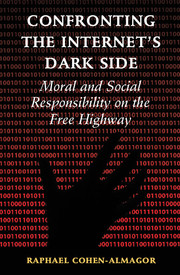Book contents
- Frontmatter
- Dedication
- Contents
- Acknowledgments
- List of Abbreviations
- Introduction
- 1 Historical Framework
- 2 Technological Framework
- 3 Theoretical Framework
- 4 Agent's Responsibility
- 5 Readers' Responsibility
- 6 Responsibility of Internet Service Providers and Web-Hosting Services, Part I: Rationale and Principles
- 7 Responsibility of Internet Service Providers and Web-Hosting Services, Part II: Applications
- 8 State Responsibility
- 9 International Responsibility
- Conclusion
- Glossary
- Selected Bibliography
- Index
1 - Historical Framework
Published online by Cambridge University Press: 05 July 2015
- Frontmatter
- Dedication
- Contents
- Acknowledgments
- List of Abbreviations
- Introduction
- 1 Historical Framework
- 2 Technological Framework
- 3 Theoretical Framework
- 4 Agent's Responsibility
- 5 Readers' Responsibility
- 6 Responsibility of Internet Service Providers and Web-Hosting Services, Part I: Rationale and Principles
- 7 Responsibility of Internet Service Providers and Web-Hosting Services, Part II: Applications
- 8 State Responsibility
- 9 International Responsibility
- Conclusion
- Glossary
- Selected Bibliography
- Index
Summary
History consists of a series of accumulated imaginative inventions.
–Voltaire
The aim of this chapter is to outline the milestones that led to the establishment of the Internet as we know it today, from its inception as an idea in the 1950s until the early 21st century. The varied and complex social and technological transformations we witness today have their roots in the way the Internet was conceived. This survey shows that the Internet was developed through research grants from the US Department of Defense's Advanced Research Projects Agency. Scientists wanted to establish a system for maintaining communication links between distant locations in the event that the electrical route was destroyed. The early Internet was devised and implemented in American research units, universities, and telecommunication companies that had vision and interest in cutting-edge research. The program grew in the 1960s and 1970s, becoming a network of computers designed to transmit information by packet switching. In 1983, Ithiel de Sola Pool wrote in what has become a classic text:
The broadband digital channel coming into the home can be multiplexed to bring in different streams at different data rates simultaneously. Subscribers can talk on the phone, have their utilities metered, watch a video picture on their television, and receive their electronic mail, all at once without interference. The loop is likely to be an optical fiber rather than a copper wire because the fiber has the needed bandwidth at lower cost.
The network of computers was, from the start, an open, diffused multi-platform. Up until the 1990s, the network developed in the United States and then, within a few years, expanded globally at remarkable pace and with no less impressive technological innovations, the end of which we are yet to witness. In its postwar incarnation, the Internet has transformed into a global system for sharing ideas and data and for exchanging text, graphics, software, music, and video clips to almost 2 billion Netusers in nearly 200 countries.
- Type
- Chapter
- Information
- Confronting the Internet's Dark SideMoral and Social Responsibility on the Free Highway, pp. 17 - 33Publisher: Cambridge University PressPrint publication year: 2015

